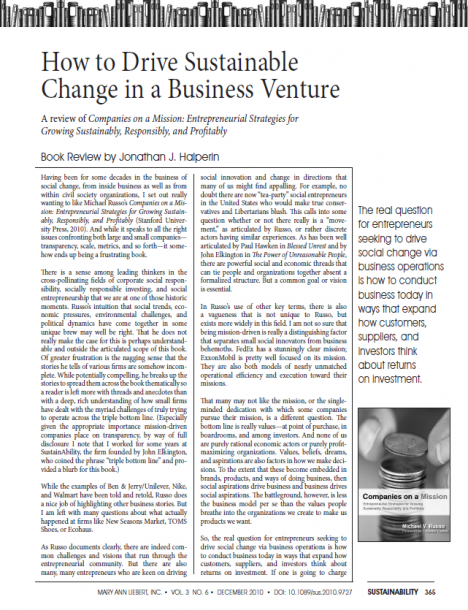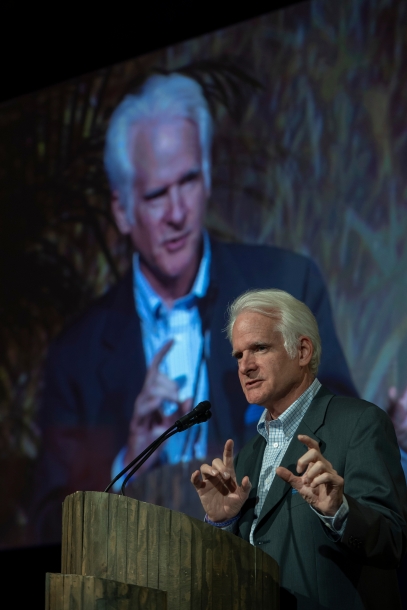You are here
How to Drive Sustainable Change in a Business Venture

Book Review by Jonathan J. Halperin
Volume: 3 Issue 6
December 15, 2010
Permalink: www.liebertonline.com/doi/pdfplus/10.1089/SUS.2010.9727
A review of Companies on a Mission: Entrepreneurial Strategies for Growing Sustainably, Responsibly, and Profitably
Having been for some decades in the business of social change, from inside business as well as from within civil society organizations, I set out really wanting to like Michael Russo’s Companies on a Mission: Entrepreneurial Strategies for Growing Sustainably, Responsibly, and Profitably (Stanford Univer¬sity Press, 2010). And while it speaks to all the right issues confronting both large and small companies—transparency, scale, metrics, and so forth—it somehow ends up being a frustrating book.
There is a sense among leading thinkers in the cross-pollinating fields of corporate social responsibility, socially responsible investing, and social entrepreneurship that we are at one of those historic moments. Russo’s intuition that social trends, economic pressures, environmental challenges, and political dynamics have come together in some unique brew may well be right. That he does not really make the case for this is perhaps understandable and outside the articulated scope of this book. Of greater frustration is the nagging sense that the stories he tells of various firms are somehow incomplete.
As Russo documents clearly, there are indeed common challenges and visions that run through the entrepreneurial community. But there are also many, many entrepreneurs who are keen on driving social innovation and change in directions that many of us might find appalling. For example, no doubt there are now “tea-party” social entrepreneurs in the United States who would make true conservatives and Libertarians blush. This calls into some question whether or not there really is a “movement,” as articulated by Russo, or rather discrete actors having similar experiences. As has been well articulated by Paul Hawken in Blessed Unrest and by John Elkington in The Power of Unreasonable People, there are powerful social and economic threads that can tie people and organizations together absent a formalized structure. But a common goal or vision is essential.In Russo’s use of other key terms, there is also a vagueness that is not unique to Russo, but exists more widely in this field. I am not so sure that being mission-driven is really a distinguishing factor that separates small social innovators from business behemoths. FedEx has a stunningly clear mission; ExxonMobil is pretty well focused on its mission. They are also both models of nearly unmatched operational efficiency and execution toward their missions.
That many may not like the mission, or the single-minded dedication with which some companies pursue their mission, is a different question. The bottom line is really values—at point of purchase, in boardrooms, and among investors. And none of us are purely rational economic actors or purely profit-maximizing organizations. Values, beliefs, dreams, and aspirations are also factors in how we make decisions. To the extent that these become embedded in brands, products, and ways of doing business, then social aspirations drive business and business drives social aspirations. The battleground, however, is less the business model per se than the values people breathe into the organizations we create to make us products we want.
So, the real question for entrepreneurs seeking to drive social change via business operations is how to conduct business today in ways that expand how customers, suppliers, and investors think about returns on investment. If one is going to charge higher prices and offer lower rates of return in the near term, the promise for the long term needs to be very compelling. We need to value longer-term returns and steadily move away from the simple metric of quarterly financial returns.
Russo slices into these deeper questions in some of the best parts of the book and raises the fundamental question of corporate structure in a brief discussion of “Benefit Corporations” that would rebalance core legal and fiduciary responsibilities across a real triple bottom line. Bringing the concept of “B Corps” into widespread use would be a profoundly significant business innovation.
Jonathan J. Halperin is president of FYI Resources for a Changing World in Chevy Chase, MD.


